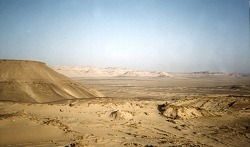
Región al oeste del valle del Nilo que se extiende hasta la frontera y el desierto de Libia. En la región hay una serie de oasis que deben su existencia a grandes cantidades de agua fósil en el subsuelo, que fluye a la superficie a través de numerosos manantiales. Los oasis más importantes son los de Bahariya, Siwa, Farafra, Dajlah y Jarga. El Fayum, que consigue su agua de una rama del Nilo, no es un oasis en el sentido estricto del término. Durante el Paleolítico el Desierto del Oeste era habitable gracias a unas lluvias abundantes. En la zona se han realizado muchos hallazgos del último periodo de la prehistoria, como cerámica, puntas de flecha y piedras de amolar. También se han encontrado restos de plantas cultivadas (cerca de Nabta, lo que la convierte en la zona agrícola más antigua de Africa) y de animales domesticados. Los oasis aparecen mencionados en los textos egipcios desde el Imperio Antiguo. Por lo menos desde los reinados de Pepy I y Pepy II había gobernadores de los oasis; sus mastabas han sido localizadas cerca de Dajla. En periodos posteriores también se mencionan frecuentemente los oasis y algunas tumbas del Imperio Nuevo tienen representaciones de gentes trayendo productos de los oasis. El templo de Edfú contiene un texto en el que se mencionan un total de siete oasis; además de los cinco ya mencionados, hay uno que no está identificado con completa seguridad (probablemente el-Hayz) y el uadi Natrum. Los restos arqueológicos van de la Prehistoria hasta la Edad Media, con una gran cantidad de monumentos fechados en la Baja Época y en el Periodo Greco-Romano. Algunos minerales eran extraídos en el Desierto del Oeste, como la amatista y cornalina en una mina que se encuentra a unos 65 kilómetros al noroeste de Abu Simbel.